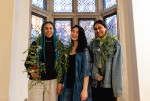Repurposed trash will be the focus of UCLA’s upcoming art show: “Our Ecological Footprint: Expressions of Environmentalism.”
The show will kick off the UCLA Renewable Energy Association’s Waste Awareness Week on Monday. Held at the Kerckhoff Art Gallery, the event will feature student-made pieces, including interactive exhibits, poetry readings, sculptures and photography – all created with an environmental mindset. Co-creator Ariana Mamnoon, a fourth-year geography and environmental systems and society student, said the event aims in part to highlight the diversity of voices in the environmental justice movement and entice students of all backgrounds to attend the week’s events. She said the movement is sometimes dominated by the wealthy, and wants to demonstrate through the show that other socioeconomic groups also partake in environmental activism.
“Environmental science is a great discipline, but there are some inequalities that exist in it,” Mamnoon said. “We had a lot of different types of people submit to (the show) and showcase that environmentalism shouldn’t be a field that is dominated by one type of person.”
Mamnoon and Liliana Epps, co-founder of Environmentalists of Color Collective at UCLA, decided over a year ago that they wanted to put on an environmental art show, driven by their passion for the environment and activist art. Mamnoon and Epps, a third-year gender studies student, teamed up with REA, which reached out to the Environmentalists of Color Collective while planning Waste Awareness Week.
“You see all these art shows happening around Westwood, and it’s cool to do one that’s taken on more of discipline and is using that to make art,” said Mamnoon.
Epps said she is most excited about the different media of art on display, such as traditional photography, poetry readings and interactive exhibits which she said will make the show more engaging. One installation is a mossy box with eyeholes for the viewer to lean in and see a landscape full of waste, representing the dangers of environmental complacency, Mamnoon said. Mamnoon said the show will even include a guided meditation.
One of the goals of the art show is also to shed light on the overwhelming amount of trash people mindlessly discard. Kayli Masuda, a first-year chemical engineering student and a planning committee member of REA, said putting the issue of excessive trash into a visual medium, particularly by repurposing it as art, draws focus to the fact that the vast majority of our trash is not repurposed, but goes to a landfill. Mamnoon said the exhibition also visually illustrates how trash can be reused.
“We have this ‘out of sight, out of mind’ mentality where we just throw things away without realizing its impact on the environment,” Masuda said. “We don’t realize it’s ending up somewhere.”
One piece that will be featured is entirely created from a single styrofoam plate with finger-painted patterns that illustrate earth, wind, fire and water. The goal of the piece is to illustrate the resilience of life in our changing environment, Mamnoon said.
Another goal of the event is to incorporate different demographic groups and art forms that are sometimes overlooked. Environmental justice representation can often have inequalities, but Mamnoon said the event hopes to showcase activists of various backgrounds and majors, and encourage greater participation in environmental science. Epps said that some pieces in the show are reminiscent of the environmental art of indigenous cultures. For example, there will be a piece rooted in how a Mexican/indigenous/mestiza and American/white-passing student navigate environmentalism with these multiple identities and cultures.
“There is a lot of art by black and indigenous people that is actually environmental art, but it might not be considered to be,” Epps said. “A lot of the pieces we’ll show next week wouldn’t necessarily be thought of as environmental art; people might think of them as indigenous issues instead, but they all go hand in hand and are intertwined.”
Ursula Heise, a professor within the English department and the Institute of the Environment and Sustainability, said environmentalism is deeply cultural; any attempt to conserve nature is entangled with cultural assumptions and values which must be addressed. Environmental activism through art and literature is not a new discipline, she said, and it is important that environmental issues are of interest to individuals of all professions and interests, since they are all responsible.
“Certainly science and technology are important, but at bottom, a lot of environmental issues are issues of value of culture and of meaning,” said Heise, “It’s what kind of nature we want to see in the future, and a lot of conservation is actually inspired by the aesthetic appreciation of particular kinds of landscapes.”
The art show will not only play an important role in bridging the gap between culture and environmental justice, but also offer a laid-back, artistic way of explaining these issues. The goal of Waste Awareness Week is to tackle the impact of waste mismanagement on the environment. After “Our Ecological Footprint: Expressions of Environmentalism,” there will be additional sustainability-centered events throughout the week, including waste reduction and awareness workshops on Wednesday and an overall audit of UCLA waste practices on Friday as the university attempts to reach its goal of zero waste by 2020.
“In the rest of the week, there might not be anything that’s geared toward people that aren’t science majors or in the environmental field, whereas art is an easy way to draw people in,” Epps said. “It can help them get an idea of what environmentalism is and what it means in a less structured, more fun way.”

These kinds of proactive positive initiatives and activities spread hope onto a seemingly hopeless environmental landscape. Those who whine about identity politics and culture can’t hold a candle to the innovation and get-‘er-done attitude of the good folk at UCLA, who remind us of the awesome potential and real-world value of diversity and collective action as we seek to remedy generational disrespect for the natural realm. That’s a long winded way of saying go UCLA.